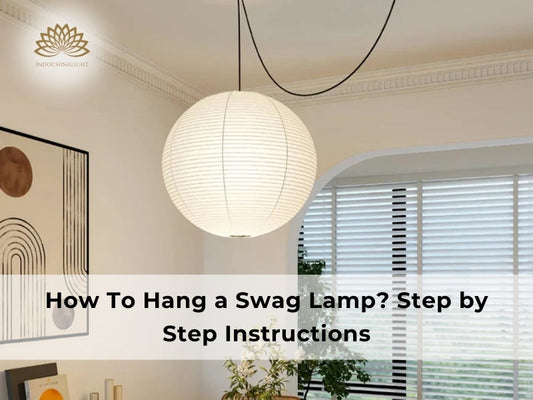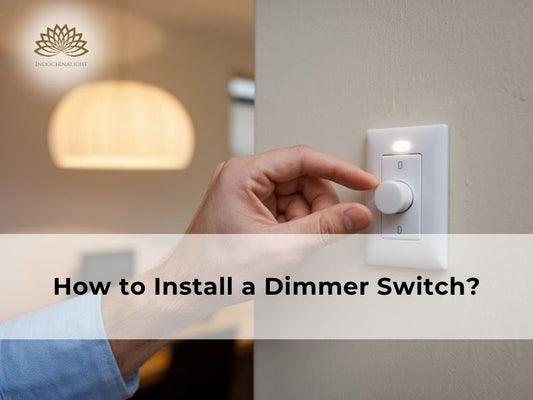Upgrading your light fixture enhances both functionality and aesthetics in your home. Many homeowners struggle with outdated fixtures but fear electrical work's complexity and potential dangers. Learning to change a light fixture saves time and money while giving you control over your home's ambiance.
This guide from IndochinaLight provides a step-by-step approach to replacing a light fixture safely and efficiently. By following these instructions, you'll transform your space with a new light fixture in under ten minutes, avoiding the frustration of trial and error and eliminating the need for expensive professional services.
Upgrading your light fixture enhances both functionality and aesthetics in your home
Tools and Materials Needed
Before starting your light fixture replacement, gather these six essential tools:
-
Voltage tester: Confirms power is off to prevent electrical shock
-
Flat head screwdriver or cordless drill: Removes and installs mounting hardware
-
Wire strippers: Exposes wire ends for proper connection
-
Wire connectors: Secures electrical connections safely
-
Needle nose pliers: Manipulates wires in tight spaces
-
Ladder: Provides stable access to ceiling fixtures
Gather essential tools like a voltage tester, screwdriver, wire strippers, and a ladder before starting
Step-by-step instruction to change a light
Changing a light fixture requires following 9 specific steps. Each step ensures safety and proper installation, from turning off power to testing the new fixture.
Step 1: Turn off the power
Locate your home's circuit panel and switch off the breaker that controls the light fixture's power. Use a voltage tester on nearby outlets to verify electricity is no longer flowing to that area. If you're unsure which circuit controls the fixture, turn on the light and test each breaker until the fixture turns off. Label this circuit for future reference, then turn off the wall switch as an additional safety measure. Never restore power until you've completed the installation and secured all connections.
Turn off the power at the circuit panel and verify it using a voltage tester for safety
Step 2: Remove decorative fixture pieces
Begin disassembling the existing fixture by removing light bulbs, glass covers, and decorative shades. Store these components safely to prevent breakage. Next, locate and remove the canopy plate that covers the mounting hardware, typically secured with one or two screws. For heavier fixtures, ask someone to help support the weight while you work on the connections to prevent accidents.
Remove bulbs, glass covers, and the fixture’s canopy plate to expose the wiring
Step 3: Remove wiring
After removing the decorative elements, you'll expose the electrical connections – typically black (hot), white (neutral), and green or copper (ground) wires with plastic caps. Test these wires with your voltage tester to confirm no current is present. Before disconnecting, take a photo or note how the wires connect to replicate this pattern with the new fixture. Carefully unscrew the wire caps and separate the fixture and ceiling wires. If you encounter uncapped wires or confusing connections, stop immediately and consult a professional electrician.
Test and disconnect the wires while noting their original connections for reference
Step 4: Remove old fixture
You can now remove the old light fixture with the wires safely disconnected. For heavier fixtures, have an assistant support the weight or stabilize your ladder while you work. Unscrew the mounting bracket that attaches the fixture to the electrical box in the ceiling and carefully lower the fixture. Before installing the new fixture, inspect the ceiling box for any damage or signs of wear that need addressing.
Detach the old fixture and inspect the ceiling box for any necessary repairs
Step 5: Measure and cut wires
For pendant or hanging fixtures, measure the desired hanging length based on your room's dimensions. Position the fixture 30-36 inches above the table surface for optimal lighting for dining areas. When cutting the fixture wires, leave an additional 8-10 inches to ensure easy connection within the ceiling box. Use wire strippers to remove approximately 1 inch of coating from each wire end, exposing the metal conductors for secure connections.
Measure and cut wires to the correct length, ensuring easy installation
Step 6: Swap hardware plates
Follow the manufacturer's instructions for installing the appropriate mounting hardware with your new light fixture. Attach the new mounting bracket to the ceiling box using the provided screws, ensuring it's securely fastened. Thread the ceiling wires through the center hole in the mounting plate, positioning them for easy access during the connection phase.
Attach the new mounting bracket to the ceiling box following the manufacturer’s instructions
Step 7: Connect wires
Match and connect wires by color – black fixture wire to black ceiling wire, white fixture wire to white ceiling wire. Twist the exposed ends together in a clockwise direction until tightly joined. Secure each connection with a wire connector, twisting it clockwise until tight. The ground wire (green or copper) connects to either the grounding screw on the mounting bracket or directly to a copper ground wire in the ceiling box. If your fixture includes specific wiring instructions, follow those for optimal performance.
Connect fixture wires to ceiling wires by color and secure them with wire connectors
Step 8: Install and assemble
Carefully tuck the connected wires into the ceiling electrical box, avoiding pinched or exposed connections. Align the fixture base with the mounting bracket and secure it according to the manufacturer's instructions, typically using provided screws or decorative nuts. Complete the assembly by installing canopy covers, glass shades, or decorative elements. Finally, install appropriate light bulbs as specified for your fixture.
Tuck the wires neatly into the ceiling box and secure the new fixture
Step 9: Turn on electricity
Return to your circuit panel and restore power to the circuit. Test the newly installed fixture by turning on the wall switch. If the fixture doesn't illuminate, reopen the power at the circuit panel and recheck your wire connections from Step 7. Loose or incorrect wire connections are the most common cause of non-functioning fixtures. Ensure wire nuts are tight and connections are secure.
Restore power at the circuit panel and test the light fixture for proper functionality
Can I change a light fixture myself?
Assess your DIY experience before attempting to change a light fixture. Consulting an electrician is the safest option if you struggle with basic tasks like changing light bulbs or suspect electrical issues beyond the fixture itself. During renovations, have professionals address suspected electrical faults before proceeding with decorative changes.
For competent DIYers comfortable with basic household repairs, replacing a light fixture for aesthetic purposes is typically manageable. The process requires attention to detail rather than specialized electrical knowledge.
When in doubt about any aspect of electrical work, contacting a professional electrician is always the wisest choice. Safety must remain your top priority – never work on electrical systems unless you've verified the circuit is completely de-energized. In many jurisdictions, electrical modifications legally require qualified personnel.
You can replace light fixtures, but consulting an electrician is recommended for complex electrical work
This guide provides a straightforward approach to changing a light fixture in under ten minutes. You can transform your space without professional assistance by following these nine steps – from safely disconnecting power to securing the new fixture. The process requires basic tools and careful attention to electrical connections, with safety precautions emphasized throughout each step.
IndochinaLight offers a range of handcrafted bamboo and rattan pendant lights that can enhance your space with natural materials and artisanal craftsmanship. Our lighting solutions combine traditional Vietnamese techniques with modern design sensibilities.
IndochinaLight - IndochinaHomeDecor LLC
-
Address: 30 N Gould St Ste. N, Sheridan, WY 82801
-
Phone: (+)1 307 249 0594
-
Email: service@indochinalight.com









